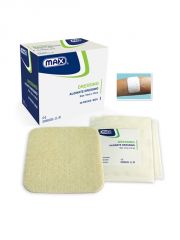![]()
![]()
![]()
Use LEFT and RIGHT arrow keys to navigate between flashcards;
Use UP and DOWN arrow keys to flip the card;
H to show hint;
A reads text to speech;
40 Cards in this Set
- Front
- Back
|
Three stages of acute wound healing? |
Inflammation Proliferation Remodeling
(some sources say that there are four phases, to include hemostasis initially)
IPR!!!! |
|
|
When does the dermis shift from non scarring to scarring wound repair? |
end of second trimester |
|
|
Main player in hemostasis/coagulation? |
platelets |
|
|
Main player in inflammatory process? |
neutrophil |
|
|
Main player in migration/proliferation process? |
macrophage |
|
|
mAIN PLAYER IN REMODELING PROCESS? |
FIBROBLASTS |
|
|
Difference between repair and regeneration? |
Repair- inflammation, proliferation, remodeling, partial thickness and full thickness wounds heal by this
Regeneration- completely restoring tissue to the way it was before injury, epidermal erosion healing only |
|
|
Primary vs Secondary vs Tertiary intention healing? |
Primary- wound edges are directly next to eachother, little tissue loss, minimal scaring occurs, sutures
Secondary- wound is allowed to granulate in, healing process can be slower
Tertiary- delayed primary, wound is observed for 4-5 days before closure |
|
|
Three over lapping phases of wound healing... generalized time frames? |
IPR
Inflammatory- starts immediately after injury, lasts 1-2 days (remember, the neutrophil is most important here)
Proliferative- reepitheliazation within first 24 hours of injury starts, but this is really going strong around day 4 (macrophages are the main player in this)
Remodeling- contraction via myofibroblasts, begins around 2 weeks (this is when fibroblasts differentiate into myofibroblasts) |
|
|
Fibroblasts produce fibronectin after injury... what does fibronectin do? |
allows fibroblasts to clot and migrate |
|
|
Platelets do more than just clot! They release growth factors... which are the most important and why? |
PDGF (platelet derived growth factor)
**TGF-B (transforming growth factor)-- platelets are the most important storage site
PDFG and TGF-B are potent PMN chemoattractants, help initiate angiogenesis |
|
|
What are the pathways in coagulation (general)? |
Intrinsic- activated by contact when blood is exposed to subendothelial tissue, leading to activation of factor X
Extrinsic- damaged tissue releases tissue factor (TF)
Final common pathway converges on thrombin to convert fibrinogen to fibrin, activates VIII, V, protine C and factor XIII |
|
|
Initial tethering of leukocytes is caused by what? |
L selectin (on leukocytes) E selectin (on endothelial cells) P selectin ( endothelial cells and platelets) |
|
|
Where is P selectin in the platelets? In the endothelial cells? |
Remember, P is on both the endothelial and platelets
L is on Leukocytes E is on Endothelial
Platelets have P selectin in alpha granules Endothelial cells have P selectin in Weibel Palade bodies |
|
|
What is responsible for vasoconstriction in initial injury? |
Serotonin |
|
|
What are the mediators of vasodilation in wounds? |
Bradykinin
PGE2 |
|
|
Matrix metalloprotinases produced by cells clear a path for fibroblasts to migrate into the wound... deficiency of what would halt this process? |
MMPs are zinc and calcium dependent
MMP1 (collagenase) MMP2, 9 (gelatinase) MMPp 3 (stromelysin) |
|
|
How long after BM reconstruction begins does it return to normal? |
7-9 days
collagen IV (most abundant), collagen VII, collagen XVII, laminin |
|
|
Proliferation and migration of fibroblasts is stimulated by... |
low pH, HYPOXIA |
|
|
Excess of what leads to keloid formation?
PDGF TGFB FGF EGF |
TGFB a/w keloid formation |
|
|
Fibroblasts differentiate into myofibroblasts at which week (for contraction)? |
week 2 |
|
|
Which collagen predominates in wound healing? |
III (replaced by I) |
|
|
Do keloids contain more or less myofibroblasts than normal scars? |
LESS- but they are PERSISTENT |
|
|
Zones that heal well via secondary intention? |
NEET!
NOSE, EAR, EYE, TEMPLE |
|
|
ABI in peripheral arterial disease? |
<0.9 |
|
|
Stages of graft healing? |
Imbibition: 48 hours, sustained by plasma exudate, ischemic period (graft is a dusky blue and looks like crap)
Inosculation: 2-3 days, vessels contract
Neovascularization: 1 week, new vessels (graft turns pink--> if this happens, it will survive)
Maturation: months, sensory innervation returns |
|
|
How much protein during wound healing? |
more than 1mg/kg/day |
|
|
Meds that inhibits wound healing? |
corticosteroids penicillamine NSAIDs nicotine |
|
|
Best dressing for a really exudative wound? |

alginate |
|
|
Dressings for increasing exudate? |
worst to best
hydrogel --> film --> hydrocolloid --> foam --> alginate |
|
|
Tensile strength by:
1 week
|
1 week 5% |
|
|
Tensile strength by:
2 weeks |
2 week 10% |
|
|
Tensile strength by:
3 weeks |
3 week 20% |
|
|
Tensile strength by:
4 weeks |
40% |
|
|
Tensile strength by:
8 weeks |
8 weeks, 80% |
|
|
Which keratins are increased in wound healing? |
K6/16 |
|
|
When treating an acute wound, which characteristic of an occlusive dressing is most important? |
moisture rention
occluded wounds heal 40% faster! |
|
|
What needle size is most commonly used for facial skin surgery? |
3/8 circle |
|
|
What are the three types of occlusive/moisture retentive dressings? |
Antimicrobial (silver, cadexomer iodine)
Non-biologic
Biologic (xenograft, allograft, autograft) |
|
|
Which dressing is the only one to show an increase in re epithelialization? |
films! (ie tegaderm) |

